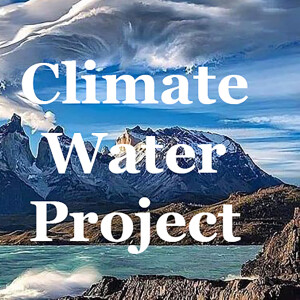
How forests increase rain : Francina Dominguez
 2022-10-26
2022-10-26
Francina Dominguez, a hydroclimatologist at the University of Illinois has been figuring out where our rain comes from. She has been tracking water as it moves across our continents. The process of moisture hopping, or moisture recycling (also known as the small water cycle in other circles), is the movement of water from air to land to air to land and so on - rain falls to the land, and then evapotranspires back up to form rain again.
She studied the droughts in the US Midwest in 2012, and found that the droughts there were related to the drought in California. Rains hop inland from California to the Midwest. When there is less water vapor in California, there will be a less moisture hopping inland. [1]
Francina Dominguez has also been researching the behavior of rain in South America. Having grown up in Colombia, which is home to part of the Amazon rainforest, she was motivated to stop it from being chopped down. When she became a hydroclimatologist, she used climate models to study the effect Amazonian deforestation would have on the water cycle.
Her simulations found something quite surprising.
Climate modelers do not always know what effects will emerge out of their models. They put in various equations and various parameters into their models, and then they wait for it to emerge a result. When Francina Dominguez modeled deforestration in the Amazon she was expecting to find that moisture recycling (aka the small water cycle) would decrease as forests were chopped down. What she instead found, to her surprise, was that the moisture recycling stayed the same, and it was the wind that increased. When the trees were cut down, the wind blew in faster which made it harder for the water vapor molecules to coalesce to form rain. Deforestation led to wind increase, and the wind increase led to rain reduction. Or to state it another way as a maxim - forests makes less wind, less wind makes more rain. [2,3,4,5,6]
Francina Dominguez has also studied the interaction of groundwater and climate. At first glance it might seem that groundwater would not affect drought and rainfall patterns. After all groundwater is underground and not touching the air. But water is a complex systems phenomena, understanding one part often requires understanding how all the parts fit together. What Francina found in her models was that groundwater would have a significant effect on rain, because it was being brought up by the root systems of the vegetation, and then would evapotranspire into the air to increase the moisture content in the air. Groundwater levels thus affect drought and rainfall patterns. [7,8]
References
[1] Herrera‐Estrada, Julio E., J. Alejandro Martinez, Francina Dominguez, Kirsten L. Findell, Eric F. Wood, and Justin Sheffield. "Reduced moisture transport linked to drought propagation across North America." Geophysical Research Letters 46, no. 10 (2019): 5243-5253.
[2] Eiras-Barca, J., Dominguez, F., Yang, Z., Chug, D., Nieto, R., Gimeno, L. and Miguez-Macho, G. (2020), Changes in South American hydroclimate under projected Amazonian deforestation. Ann. N.Y. Acad. Sci., 1472: 104-122. https://doi.org/10.1111/nyas.14364
[3] Sud, Y. C., Shukla, J., & Mintz, Y. (1988). Influence of Land Surface Roughness on Atmospheric Circulation and Precipitation: A Sensitivity Study with a General Circulation Model, Journal of Applied Meteorology and Climatology, 27(9), 1036-1054. Retrieved Oct 6, 2022, from https://journals.ametsoc.org/view/journals/apme/27/9/1520-0450_1988_027_1036_iolsro_2_0_co_2.xml
[4] Yang, Zhao, and Francina Dominguez. "Investigating land surface effects on the moisture transport over South America with a moisture tagging model." Journal of Climate 32, no. 19 (2019): 6627-6644.
[5] Chug, Divyansh, Francina Dominguez, and Zhao Yang. "The Amazon and La Plata River Basins as Moisture Sources of South America: Climatology and Intraseasonal Variability." Journal of Geophysical Research: Atmospheres 127, no. 12 (2022): e2021JD035455
[6] Martinez, J. Alejandro, and Francina Dominguez. "Sources of atmospheric moisture for the La Plata River basin." Journal of Climate 27, no. 17 (2014): 6737-6753
[7] Martinez, J. Alejandro, Francina Dominguez, and Gonzalo Miguez-Macho. "Effects of a groundwater scheme on the simulation of soil moisture and evapotranspiration over southern South America." Journal of Hydrometeorology 17, no. 11 (2016): 2941-2957.
[8] Martinez, J. Alejandro, Francina Dominguez, and Gonzalo Miguez-Macho. "Impacts of a groundwater scheme on hydroclimatological conditions over southern South America." Journal of Hydrometeorology 17, no. 11 (2016): 2959-2978
More Episodes
 2024-04-19
2024-04-19
 2024-01-21
2024-01-21
 2023-03-31
2023-03-31
 2022-11-30
2022-11-30
Create your
podcast in
minutes
- Full-featured podcast site
- Unlimited storage and bandwidth
- Comprehensive podcast stats
- Distribute to Apple Podcasts, Spotify, and more
- Make money with your podcast
It is Free
- Privacy Policy
- Cookie Policy
- Terms of Use
- Consent Preferences
- Copyright © 2015-2024 Podbean.com





